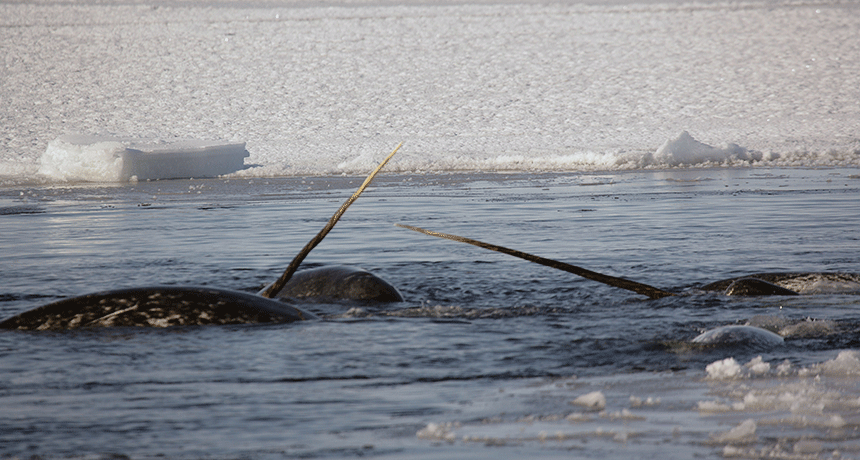Escaping narwhals can freeze and flee at the same time
When diving away from people, the heart rate of these ‘tusked’ whales plummets to almost nothing

Narwhals are known as “unicorns of the sea” for their single, enormous tooth. But these mammals have another oddity. During frantic escape dives, their heart rates slow dramatically.
M.P. Heide-Jørgensen
When an animal senses danger, it might freeze to try to avoid being seen. Or it might flee, to try to get away. But when narwhals encounter people, they do a bit of both, a new study finds.
After escaping from a net, these whales dove deep underwater. That part of their reaction looked like fleeing. At the same time, their heart rates and breathing slowed, as if they were trying to hide.
It’s an unusual combo. Normally the heart races during intense physical activity. That helps pump more blood, oxygen and nutrients to working muscles. And the narwhals’ escape dives definitely qualify as intense activity. During those dives, they pump their tails at rates of up to 25 strokes per minute. So this drop in heart rate was surprising — especially as it was so dramatic.
Indeed, says Terrie Williams, “That was astounding to us.” As an ecophysiologist (EE-koh-fih-zee-OL-oh-gizt) at the University of California, Santa Cruz, she studies how animals’ body functions affect how they interact with their environment. “There are other marine mammals that can have heart rates that low, but not typically for that long a period of time. And especially not while they’re swimming as hard as they can.”
Narwhals are well-adapted to diving. Their main food is deep-dwelling ocean fish. During their main feeding season, these whales can dive 800 to 1,500 meters (2,400 to 4,500 feet) below the Arctic sea ice for 25 minutes at a time. But like other mammals, they need to breathe air. To conserve oxygen while foraging for food, they can slow their body functions. The normal heart rate for a narwhal is about 60 beats per minute. That’s similar to what’s seen in people. But during a long underwater feeding session, a narwhal can drop its heart rate to just 10 or 20 beats per minute.
To evade natural predators such as killer whales, narwhals don’t usually dive away. Instead, they tend to hide. They may sneak under ice sheets or huddle in spots too shallow for their pursuers, Williams notes.
But in response to people, they react very differently. “When narwhals detect humans, they often dive quickly and disappear from sight,” observes Kristin Laidre. She is an ecologist at the University of Washington in Seattle. Although she studies Arctic narwhals, she did not take part in this study.
Williams worked with research colleagues from Denmark. During these escape dives, they wanted to know what happens to the whales’ bodies. To do this, they partnered with Indigenous hunters in East Greenland. The hunters knew how to capture narwhals in nets. The researchers used suction cups to stick monitoring equipment to the narwhals’ backs. After releasing the creatures, this team tracked tail strokes and heart rates in the whales. They used these data to calculate how much energy the narwhals used during their deep escape dives.
Dives to feed were different from those that came after being entangled in a net for an hour or more. During escape dives, Williams explains, “the heart rates were going down to levels of three and four beats per minute!” And they stayed “at that level for 10 minutes at a time.”
Her team observed the narwhals making multiple dives in the hours following their escapes. And they dove deeply — 45 to 473 meters (about 150 to 1,500 feet) down. Such dives burned about twice as much energy as normal feeding dives. Those post-escape dives burned up three to six times more energy than when the animals were at rest.
Frantic getaways, combined with super-low heart rates, take a steep toll. Escape dives gobbled up 97 percent of the available oxygen in the narwhals’ lungs, blood and muscles, the authors calculated. That’s almost twice the 52 percent used up during normal dives of similar depth and duration.
So far, Williams says, these costly escapes have been observed only after a prolonged interaction with people. It’s not yet known whether such an extreme physical response could weaken the animals over time.
The international team of researchers shared its findings December 8, 2017 in Science.
This new study highlights how the behavior of these whales makes them especially vulnerable to interactions with people, Laidre says. And, she adds, such human contact is “likely to increase in the Arctic with sea ice loss.” Less ice means more boats and more encounters with people. Seismic exploration, hunting and noise from large vessels and fishing boats also can disturb wildlife. Today, narwhals already are a species that is nearly threatened with extinction. So conservation efforts must account for human impacts, Laidre says.
Williams’ group plans to investigate whether narwhals show the same flee-and-freeze reaction to other disruptions. They also want to track any long-term health effects of such extreme escapes.
“There is a concern from our group that this is just pushing the biology of these animals beyond what they can do,” Williams says.







